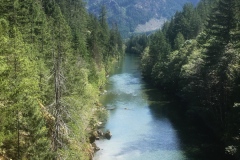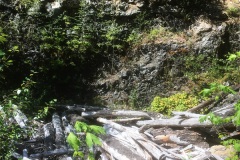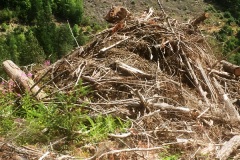
A cut block on a hillside in the Comox Lake watershed / Pat Carl photos
Take a hike, see devastation in the Comox Lake watershed
When I first moved permanently to the Comox Valley, I met a man who knew the Valley well and many of its paths and trails, those well known and those obscure. He took people on hikes during which he shared his knowledge of the area. I often think of the gift he gave me and others.
One time, a group of us took a hike with him that started at the dam near Comox Lake and ended at Nymph Falls. As I recall, the area during that season was a beautiful and rich emerald green and smelled of softwood pine needles and sap. That was some 15 years ago.
I returned to the dam and lake last weekend with four others. All of us are members of Save Our Forests – Comox Valley, SOFT – CV for short. We were interested in seeing firsthand the extent of the timber harvest currently being conducted by TimberWest throughout the Comox Lake watershed, which is the source of drinking water for most of the Comox Valley.
We traveled some 15 kilometres around Comox Lake and up logging roads along the Cruickshank River, one of the many rivers and streams that feeds into the Lake.
Theoretically, we were prepared for the clear-cutting, but seeing it for ourselves brought home the amount of devastation. Cut block after cut block dotted the sides of steep hills and mountains and came within a hair’s breadth of the Cruickshank. We wondered aloud how TimberWest, with a straight face, could claim, as its website does, to be stewards of its lands that “respect cultural, economic and environmental values.”
I was also struck by the amount of waste that TimberWest’s “stewardship” creates. Weathered and newly created piles of slash waiting to be burned, thick wire ropes lying in the dirt alongside twisted and abandoned metal culverts, logging roads like bleeding veins cutting through the harvested areas, treeless exposed understory with its loose rocks and soil just waiting for a strong winter rain to send it down into the Cruickshank unimpeded, and trees, like the twisted rust-red arbutus beauties, caught up in the clear-cutting onslaught.
What beauty remains in the area is created by the hardwood trees which TimberWest doesn’t consider economically harvest-worthy. The dappling sunshine drifting through what little canopy remains brought to mind what it must have been like before TimberWest became the area’s owner with free rein to log right on top of the watershed that drains into Comox Lake, the source of Courtenay/Comox’s drinking water.
And you wonder why a new water treatment facility is planned for the Comox Valley, costing $126 million to construct and then an estimated $86 yearly operating cost to be shouldered by each Courtenay and Comox household for the next 25 years.
Want to see the devastation yourself? You’ll need to drive a 4×4 vehicle to naviagate the logging roads. And you will need to check TimberWest’s website for current accessibility restrictions. It’s their privately-owned land, after all.
But it’s our watershed and our drinking water.
Pat Carl is a frequent contributor to Decafnation and a participant in the Comox Valley Civic Journalism Project. She can be reached at patcarl0808@gmail.com
GET CONNECTED BY WATER, LEARN ABOUT THE COMOX LAKE WATERSHED PROTECTION PLAN
High quality drinking water is produced by a healthy, properly functioning ecosystem. Clean water is the outcome of watershed-scale and riparian processes that capture, store and release water while simultaneously reducing or removing suspended sediments, bacteria, viruses, parasites and excess nutrients.
Protecting our drinking water requires two important steps: treating the water and protecting the source. The area of land that drains into Comox Lake is approximately 461 square kilometres, and the majority is privately owned. Much of the area is also K’ómoks First Nation (KFN) traditional territories. Balancing interests such as private ownership, traditional use, active logging, recreation, and hydroelectric power generation, while providing drinking water and sustaining critical fish and wildlife habitat, is a long-term endeavour.
— Comox Valley Regional District website
SUBSCRIBE TO OUR NEWSLETTER
On Merville groundwater extraction it’s deja vu all over again
Regional district staff recommend approving an amended application for groundwater extraction in Merville as a “home occupation,” but rural area directors want more clarity on its legal definition
Merville water bottling issue returns to the CVRD, highlights provincial water policies
The Comox Valley Electoral Areas Service Commission will consider on Monday an amended application for water bottling operations in Merville and draw attention to larger water policy issues in British Columbia
What’s dire: the lack of Comox subdivisions or climate change and gradual deforestation?
A Comox Valley developer is suing the Town of Comox because his permits to cut down trees and build more single-family homes haven’t been issued as fast as he’s wanted and because the town wants a wider walking trail through the property
Join the discussion Oct. 3 about food system security in the Comox Valley
The Watershed Sentinel magazine is hosting a zoom webinar Oct. 3 on food system security in the Comox Valley
Comox Valley Nature webinar to discuss effect of climate change on marine life
Comox Valley Nature lecture to discuss how this summer’s heatwave killed off billions of sea life and the future for marine ecosystems
New North Island organics processing facility raises concerns about cost, fire and odours
Campbell River environmentalists raise concerns about the the cost and location of the Comox Strathcona Waste Management Commission’s new organics processing facility
THE WEEK: 5 things wrong with how Comox tried to hide sewage spill information
Comox Town Council has nothing to say about raw sewage leaking into Brooklyn Creek beyond issuing a press release, which makes misleading statements
Tonnes of sewage mud removed from Brooklyn Creek, nearby residents say its been piling up for years
A Town of Comox infrastructure failure could have spilled raw sewage into Brooklyn Creek for a long time, according to nearby residents who have noticed unusual plant growth and sewage-type odours for nearly 24 months. Mayor and councilors say they didn’t know about it
Town of Comox spills raw sewage into Brooklyn Creek, doesn’t inform public
A broken pipe has spilled raw sewage into Brooklyn Creek and it appears that efforts to mitigate the damage have created a high level of turbidity, a double whammy for fish as well as a potential public health concern. But the Town of Comox has not yet formally informed the public.
Campbell River Environmental Committee lists its current top priorities
The Campbell River Environmental Committee has kept North Island residents aware of environmental risks and promoted awareness of potential concerns to help government and industry make informed decisions







I’d like to see this article printed in our local paper as so the ones who don’t know about this website can read it. Am I reading this right? Our tax money is being used to build new infrastructure while the logging continues and it can only get worse? This is happening around the province, much of it done by the government owned forestry company so does that mean we’re complicit as co-owners? Just like we’re complicit as shareholders in BC Hydro and the destruction of the Peace Valley? Somehow I find this very unsettling.
Great article – thanks. But it’s always a tad troubling to read comments that attempt to rationalize clear-cutting above rivers or lakes when there is no logical excuse for it. I’m also concerned by comments that strive to minimize the importance of turbidity in drinking water.
I’ll admit, after experiencing far too many boil water notices in the Comox Valley, I was curious about the implications of turbidity in our water. Why such a big deal?
In a nutshell: Turbidity is the presence of suspended particles, and more than a few of these substances are harmful to the human digestive system, not to mention fish. So during heavy rain events, all sorts of stuff from the forest floor, including seepage from animal remains or their feces, human waste from human activities, improperly disposed of materials and fluids from logging activities, etc., enters our drinking water source.
In drinking water the higher the level of turbidity, the higher the chance that those using it could develop gastrointestinal diseases. Contaminants like viruses and pathogenic bacteria can easily attach themselves to the suspended solids. These solids then interfere with disinfection.
High turbidity levels can reduce the amount of light reaching lower depths in bodies of water like rivers, lakes and reservoirs, which inhibits growth of some forms of aquatic plants and can negatively affect species that are dependent on them, like fish and shellfish. High turbidity levels will also hinder a fish’s ability to absorb dissolved oxygen.
The RD is spending 140 million dollars because VIHA changed turbidity levels from 2ppm to 1ppm. The water has always been safe to drink. Spending money on intake when the supply lines are leaking all over town.
According to the the Comox Lake Watershed Protection Plan (see link below) the hazards that posed the greatest risks to water quality in the Comox Lake watershed are:
Very High Risk Rating:
• Camping in undesignated areas in the watershed, especially near the lakeshore or other riparian areas
• Augmentation/concentration of streamflows
• Wildfire
• Off Road Vehicle use (ATV’s, side-by-sides, dirt bikes, snowmobiles) off of maintained roads
• Flooding on the order of a 100- to 200- year event
High Risk Rating:
• Drought
• Intentional harm to the water source or watershed
• Earthquake resulting in the loss of the BC Hydro Dam
• Aircraft accident on Comox Lake
• Sewage management facilities
• Body contact recreation on Comox Lake (parasites and viruses)
• Trails and non-motorized trail use (hiking, mountain biking, horse riding, cross-country skiing and snowshoeing)
• Timber harvesting- cutblock location and extent
• Wildlife contamination of Comox Lake
https://www.comoxvalleyrd.ca/sites/default/files/docs/Projects-Initiatives/2-20160603_cvrd_wpp_final.pdf
According to the report, timber harvesting is not one of the very high risks.
Can anyone explain how camping is a greater risk to our watershed than clear cut forestry? I’m confused.
Yes, thanks for this, Pat. I’m glad to see there’s more focus happening on our watershed. Save Our Forests Team-Comox Valley (SOFT-CV) is a local group that plans to take up the watershed issue in the fall. In the interests of full disclosure, Pat, Jeff and I are members of that group. Check out our Facebook page (https://www.facebook.com/groups/1072292616310599/) and ask to join the group. Our watershed is privately owned and there is little oversight and even less control over what happens there. In the era of global heating, water is going to become even more of an issue than it would otherwise, and governmental approaches to managing watersheds need to change. I believe Elder College is also going to be focusing on watersheds this fall/winter. We need more citizen engagement on this.
I somewhat agree with the writers comments… only to the extent that there is some waste metal laying about in the forest. It should be asked if this debris is from recent harvesting activity or historical activity. The writer if they researched properly would discover this area has been harvested three times going back to the early 1900’s. My personal experience is that yes the timber companies have replaced culverts with new in order to access the timber and yes I feel that the companies should be mandated to remove waste debris. But the volume of waste left in the forest is far less than the past. Many people have discovered old steam donkeys abandoned in the forest, I personally have found evidence of old logging camps abandoned to the forest. Is it better then it was? Yes. Is there room for improvement? Yes.
As for the “waste” wood left behind. The timber companies are harvesting marketable material. They’ve proven techniques to determine the value of the timber. If you come up to a site where the logs have been stacked you’ll notice letters and numbers on the butt ends indicating type and value. Timber left in the forest has no value to the companies. As for those slash piles. After the timber companies have left the area and before they decommission the roads two things happen. First there is a high probability that the company with offer access to the slash piles to the public and firewood companies to harvest the wood from those piles. In some areas (north of Campbell River is one example) there are opportunities for the public/firewood companies to harvest 6-8 foot lengths of downed timber. Second, crews will go into the harvested cut blocks and replant. Now in order to replant it is necessary for some downed timber to remain behind to stabilize to forest floor. Is it a perfect solution? No but if you to look at areas of the world where every stick of wood was removed, you’ll see massive landslides. Much bigger then what is spoke about in this article. After all of this activity the companies with make a determination whether the logging roads and spur roads will be deactivated. This could involve simply ditching the road or in some cases completely removing the road, re-sloping to match the local topography. Boulders waste logs are used to farther stabilize the slope.
In closing the timber companies do not simply walk away from the forest after the marketable timber is removed. They’ve government regulations to follow and those rules are generally followed. Are shortcuts taken? Likely yes but again are things better than the past? Yes. I’ve been up the Cruikshank Canyon back in the early 1970’s and again in 2017-18… vastly different approaches to logging in that area.
It’s interesting to read a rationale which provides a partial defense of cutting practices on the steep slopes of our watershed. From Mr. Barth’s account I take away the following:
1) logging practices in the area aren’t perfect but they’ve improved a lot – plus, we’re not talking virgin wilderness here.
2) Timber West does it’s due diligence through: leaving material on the ground to stabilize it during storms, allowing the public in to collect firewood, and replanting.
Have I missed anything? Regardless, none of the above is enough justification for the BC Government to allow private companies to “harvest” in our watershed, much of this “harvest” being shipped off with poor returns for the province and the Comox Valley which then has to deal with the inevitable results for our watershed and the infrastructure needed to utilize our watershed.
I have often hiked this area and I have also seen the helicopter video, all of which demonstrated vividly just what devastating impacts these logging practices have had along the Cruikshank and throughout the watershed.
I’m sorry, but ‘it’s not as bad as it used to be, these practices have always occurred, and we just don’t understand all the good things TimberWest does’ – all of this is simply rationale to excuse the status quo. And the status quo simply isn’t good enough.
The devastation is occurring across the island. This is NDP management of forests. Heli-logging is taking out old growth along the edges of Strathcona Park on 80degree slopes, over Buttle lake and beyond. For the first time since the early seventies I have been seeing what we used to call “4-log” logging trucks. I wonder who will take responsibility for futuire negative impacts?
Loys,
You stated that this is an NDP government issue but it was the Liberal government that SOLD Crown land to logging companies so they could do whatever they wanted with ‘their’ land. And now you see great swaths of land that has been logged and is now for sale ‘for development’. Hundreds of acres of logged land are for sale in my hometown of Lake Cowichan. That is not managing our forests. That’s plain rape and then sell for more profit. And not keeping these lands for future harvests is a waste of a good resource.
C. Johnson. I am sorry but you can’t blame the big bad Liberals on this. This sales were done by BC Timber Sales, which is under the aegis of the current NDP. This is just normal NDP election betrayal we get everytime the NDP is in power. NDP owns this. See: https://www.cbc.ca/news/canada/british-columbia/old-growth-logging-1.4689648
Thanks for the article Pat. I would just like to say one does not need a 4×4 to navigate many of the logging roads. I drove a Toyota Yaris and had no problem accessing Kweishun Creek quite a ways in before the road became too rough.